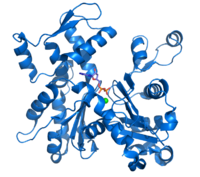
Photo from wikipedia
Folding of an RNA from secondary to tertiary structure often depends on divalent ions for efficient electrostatic charge screening (nonspecific association) or binding (specific association). To measure how different divalent… Click to show full abstract
Folding of an RNA from secondary to tertiary structure often depends on divalent ions for efficient electrostatic charge screening (nonspecific association) or binding (specific association). To measure how different divalent cations modify folding kinetics of the 60 nucleotide E coli rRNA GTPase center, we combined stopped-flow fluorescence in the presence of Mg2+, Ca2+, or Sr2+ together with time-resolved small angle X-ray scattering (SAXS) in the presence of Mg2+ to observe the folding process. Immediately upon addition of each divalent ion, the RNA undergoes a transition from an extended state with secondary structure to a more compact structure. Subsequently, specific divalent ions modulate populations of intermediates in conformational ensembles along the folding pathway with transition times longer than 10 msec. Rate constants for the five folding transitions act on timescales from submillisecond to tens of seconds. The sensitivity of RNA tertiary structure to divalent cation identity affects all but the fastest events in RNA folding, and allowed us to identify those states that prefer Mg2+ The GTPase center RNA appears to have optimized its folding trajectory to specifically utilize this most abundant intracellular divalent ion.
Journal Title: RNA
Year Published: 2018
Link to full text (if available)
Share on Social Media: Sign Up to like & get
recommendations!